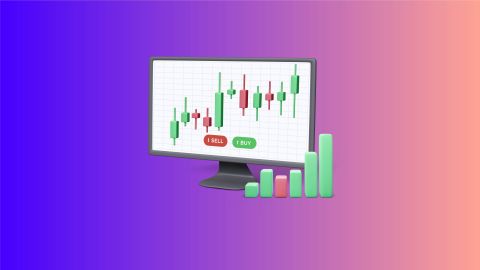A crucial tool for assessing a company's performance in the business world is its financial statements. Among these, the trading and profit and loss account highlights whether a business is profitable at a specific point in time. Therefore, understanding the meaning of the trading and profit and loss account is vital for making informed investment decisions, regardless of the financial instrument involved.
Let us understand this concept in detail and learn its various types and benefits.
What is a trading account?
A trading account is a financial statement used to determine the gross profit or loss a business makes from trading activities. It primarily records the purchases and sales of goods, along with the associated costs like direct expenses. The trading account is crucial in showing how efficient a business is at converting stock into revenue. It helps in calculating gross profit, which is the difference between sales and the cost of goods sold, offering insights into the company's operational performance.
What are profit and loss account?
A profit and loss account provides a detailed summary of the net profit or loss a business has made over a specific period. It records all revenue and expenses that have occurred in the business operations. While the trading account focuses on gross profit, the profit and loss account offers a clearer picture of net profitability. It typically ends by transferring any balance to the capital account, ensuring that business owners or stakeholders can assess financial health accurately.
Here are the types of expenses that can be included in a Profit and Loss Account:
- Sales Tax
- Maintenance
- Depreciation
- Administrative Expenses
- Selling and Distribution Expenses
- Provisions
- Freight and Carriage on Sales
- Wages and Salaries
These expenses are recorded on the debit side of the Profit and Loss Account, while items such as Commission Received, Discount Received, and Profit from the Sale of Assets are noted on the credit side.
To calculate the net profit, subtract business expenses from the gross profit and add any other income received:
Net Profit = Gross Profit – Expenses + Other Income
Closing Entries for Net Loss or Net Profit:
1. For Net Loss:
- Capital A/c – Dr.
- To Profit and Loss A/c
3. For Net Profit:
- Profit and Loss A/c – Dr.
- To Capital A/c
Types of Profit and Loss Account
Profit and loss accounts can be categorized into three main types, each serving a distinct purpose.
Gross Profit and Loss Account
This account calculates the gross profit by comparing sales with the cost of goods sold. It indicates the business's basic profitability from its trading activities.
Operating Profit and Loss Account
This account includes the expenses and revenues directly related to business operations. It helps in understanding how well a company manages its day-to-day functions.
Net Profit and Loss Account
This type gives a final figure by considering all the revenues, expenses, and taxes. It represents the overall profitability after all costs have been deducted from total revenues.
Trading Account and Profit and Loss Account format
The format for both the trading account and profit and loss account follows a standard template to ensure clarity and transparency. The trading account records the opening stock, purchases, and direct expenses on the debit side, while the sales and closing stock appear on the credit side. The profit and loss account lists indirect expenses such as salaries, rent, and interest on the debit side and non-operating income on the credit side. This format enables businesses to easily assess their operational efficiency and overall profitability over a given period.
Benefits of trading and profit and loss account
A trading and profit and loss account helps market participants determine:
1. Performance evaluation
- It allows traders to assess the gross and net profit or loss of their trading activities over a specific period.
- By analysing the net profit or loss, they can determine whether their trading strategies are successful or need adjustments.
- For example:
- Say a trader analyses their trading and profit and loss account.
- Upon observation, the trader realised that they are consistently incurring losses.
- The trader decides to:
- Reconsider their trading approach or
- Seek professional advice
2. Tax reporting
- The trading and profit and loss account provides essential data for tax reporting purposes.
- Using it, traders can accurately report their trading profits or losses to comply with tax regulations.
3. Performance benchmarking
- By comparing the trading performance over different periods, traders can benchmark their performance.
- This benchmarking helps in setting realistic goals for future trading activities.
Difference between Trading Account and Profit and Loss Account
When managing your business finances, it's crucial to understand the distinction between a Trading Account and a Profit and Loss (P&L) Account. Here's a breakdown of their key differences:
Feature |
Trading Account |
Profit and Loss (P&L) Account |
Purpose |
Records all transactions related to buying and selling of goods. |
Calculates the net profit or loss for a specific period. |
Information Included |
Opening stock, purchases, sales, closing stock. |
Revenue, cost of goods sold, operating expenses, other income/expenses. |
Result |
Shows gross profit (sales - cost of goods sold) or gross loss. |
Shows net profit (revenue - expenses) or net loss. |
Position in Accounting Cycle |
First stage, used to calculate the cost of goods sold. |
Second stage, builds upon the Trading Account. |
Types of trading account
Thanks to the financial evolution and increased participation in the financial markets, nowadays, brokerage firms offer several types of trading accounts. These usually cater to the specific needs and preferences of investors and traders. Let’s have a close look at some of the most common types:
1. Equity trading account
- This type of brokerage account is specifically designed for buying and selling company stocks or equitie.
- It allows investors to trade in equities but cannot be used to:
- Subscribe to an IPO or
- Trade in commodities
An equity trading account is further divided into three variations:
| types of equity trading account | Meaning | Example |
| Cash trading account |
|
|
| Margin trading account |
|
|
| Day Trading Account |
|
|
2. Commodity trading account
- A specialised brokerage account that enables the buying and selling of commodities such as:
- Gold
- Silver
- Agricultural products
- Oil, and many more
- It provides investors with access to commodity markets where they can trade various commodities and derivative contracts, including futures and options.
- It must be noted that one of the primary functions of a commodity trading account is to facilitate trading in commodity futures contracts.
3. Options trading account
- An options trading account allows investors to buy and sell options contracts.
- An options contract gives them the right (but not the obligation):
- To buy or sell an underlying security
- At a predetermined price
- Within a specified time frame
Conclusion
A trading and profit and loss account is like a financial statement in which all the market trades get recorded. Their primary goal is to determine profitability and assess trading performance. Additionally, traders use them to adjust their trading strategies and comply with tax regulations.
In India, brokerage houses offer a variety of trading accounts, such as equity, commodity, and options, to meet the diverse trading needs of market participants.
Read related articles:
Different types of stock trading
Difference between Demat and trading account




